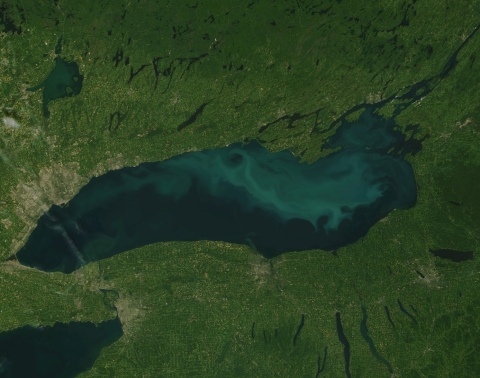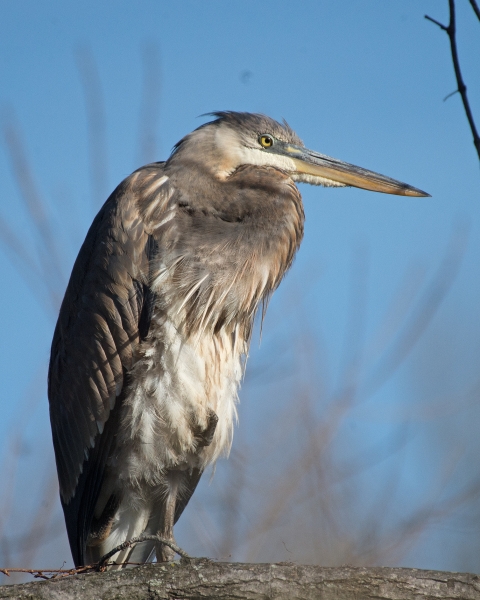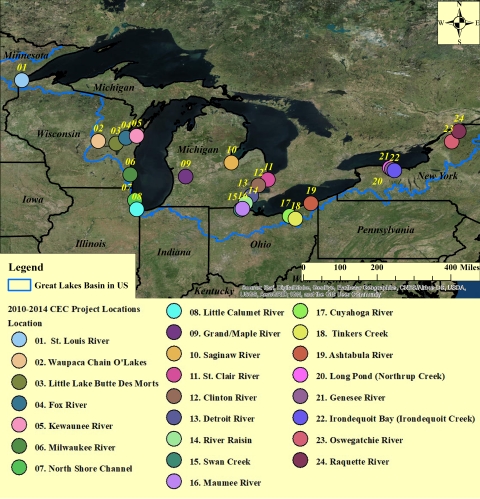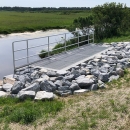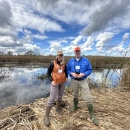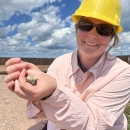What is the Great Lakes Restoration Initiative?
The Great Lakes Restoration Initiative was launched in 2010 to accelerate efforts to protect and restore the largest system of fresh surface water in the world. So far, Great Lakes Restoration Initiative resources have been used to fund over 2,000 projects to improve water quality, to protect and restore native habitat and species, to prevent and control invasive species invasive species
An invasive species is any plant or animal that has spread or been introduced into a new area where they are, or could, cause harm to the environment, economy, or human, animal, or plant health. Their unwelcome presence can destroy ecosystems and cost millions of dollars.
Learn more about invasive species , and to address other Great Lakes environmental problems. Projects that the U.S. Fish and Wildlife Service New York Field Office has led and assisted include projects in the following programs: Endangered Species, Environmental Quality, Conservation Planning Assistance, and Partners for Fish and Wildlife.
For our Endangered Species program, GLRI funds have supported recovery actions for threatened and endangered species in the Great Lakes basin within the State of New York. For example, we have funded surveys for bog turtles (Clemmys [Glyptemys] muhlenbergii) and Indiana bat (Myotis sodalis). As the lead field office for the recovery of the Chittenango ovate amber snail (Novisuccinea chittenangoensis) we have worked in partnership with SUNY ESF, the Rosamond Gifford zoo, NYSOPRHP, and NYSDEC to implement a captive breeding program and monitor the status of the species in the wild. Only known to occur at Chittenango Falls State park, this partnership has worked diligently to reduce threats to the Chittenango ovate amber snail and teach others about its importance. The endangered Great Lakes population of piping plover (Charadrius melodus) conservation and recovery effort has also benefitted from GLRI contributions. We have funded NYSOPRHP to monitor birds and conduct outreach to beachgoers as the plovers have recently started to nest along the eastern shore of Lake Ontario after a 30-year hiatus! Funds from GLRI have also been used to establish a propagation program for American hart's‐tongue fern (Asplenium scolopendrium var. americanum), started at SUNY-ESF, and now being implemented by NYSOPRHP. We also funded SUNY ESF to study the effects of invasive Japanese knotweed and herbicides on Leedy’s roseroot (Rhodiola integrifolia subsp. Leedyi).
For our Conservation Planning Assistance program, projects have enhanced information related to shoreline and open water migration corridors and utilization of Great Lakes islands by migratory and breeding birds and bats. In the Partners for Fish and Wildlife program, projects restored habitats for native lake sturgeon (Acipenser fulvescens), brook trout (Salvelinus fontinalis), migratory birds, and threatened and endangered species populations within the Great Lakes Basin by removing fish passage fish passage
Fish passage is the ability of fish or other aquatic species to move freely throughout their life to find food, reproduce, and complete their natural migration cycles. Millions of barriers to fish passage across the country are fragmenting habitat and leading to species declines. The U.S. Fish and Wildlife Service's National Fish Passage Program is working to reconnect watersheds to benefit both wildlife and people.
Learn more about fish passage barriers, stabilizing stream banks, improving instream habitat, and restoring wetland and upland areas to benefit priority species.
In the Environmental Quality program, projects conducted included an emerging contaminants study, a fish tumor study, a colonial waterbird population study, a marsh anuran and bird study, habitat evaluation and restoration, and technical assistance to Areas of Concern. More details about GLRI-funded environmental quality projects are provided below.
GLRI Resources:
Areas of Concern (AOCs)
Areas of Concern are locations that have experienced environmental degradation and are targeted for restoration and enhancement under the Great Lakes Restoration Initiative. Within New York, AOCs include Niagara River, Buffalo River, Eighteenmile Creek, Rochester Embayment, and the St. Lawrence River.
AOC Resources:
- EPA List of Great Lakes AOCs
- NYSDEC Areas of Concern
- Fish Tumor and Other Deformities BUI, Niagara River AOC, Fact Sheet
Rochester Embayment Area of Concern
The New York Field Office conducted a focused assessment of wetlands within and adjacent to the Rochester Embayment Area of Concern (REAOC) in support of Area of Concern (AOC) delisting evaluations concerning the Loss of Fish and Wildlife Beneficial Use Impairment (BUI) which had been identified as “impaired." Among delisting criteria and recommended actions for removing the habitat loss BUI are requirements to assess trends in wetland size and condition, and rank wetland habitats for preservation and restoration. The project area included wetlands associated with 18 waterbodies, including Lake Ontario, bays, ponds, streams, and the Genesee River in and adjacent to the AOC. Major findings included a general loss of wetland extent over six decades, principally due to development, erosion, and natural shifts in wetland margins. Declines in habitat quality were attributed to reduced habitat diversity/complexity. Assessment findings provided the basis for targeted habitat improvement projects resulting in approximately 96 acres of restoration/enhancement, 1800 linear feet of new connective channels, and plantings of over 31,500 bare root or live stake native herbaceous plants and shrubs.
- Loss of Fish and Wildlife Habitat BUI, Rochester Embayment AOC, Fact Sheet
- Wetland Assessment, Rochester Embayment AOC, Support of the Loss of Fish and Wildlife Habitat BUI Removal Evaluation
- Wetland Restoration Recommendations, Rochester Embayment AOC, Support of Loss of Fish and Wildlife Habitat BUI Removal
- Wetland Habitat Assessments at the Rochester Embayment AOC on the South Shore of Lake Ontario, USA
Niagara River Area of Concern Marsh Anuran and Avian Population Monitoring
In April 2014 a Work Plan was developed that identified survey protocols to be used over a 5-year period (2014-2018) for assessing the "Degradation of Fish and Wildlife Populations" Beneficial Use Impairment within the Niagara River Area of Concern (NR AOC). The Work Plan specifically identified methods used for conducting surveys to facilitate population trend assessments for sentinel native anuran species and focal marsh bird species known to occur in the NR AOC. Anuran species targeted for population trend assessments include the northern leopard frog (Lithobates pipiens), American toad (Anaxyrus americanus), and the bullfrog (Lithobates catesbeianus). Targeted focal marsh bird species include the least bittern (Ixobrychus exilis), sora (Porzana carolina), Virginia rail (Rallus limicola), king rail (Rallus elegans), American bittern (Botaurus lentiginosus), common gallinule (Gallinula galeata), American coot (Fulica americana), and pied-billed grebe (Podilymbus podiceps).
- Final 2014-2018 Anuran and Marsh Bird Work Plan
- Final Anuran and Marsh Bird Survey Report: Year 1 (2014)
- Final Anuran and Marsh Bird Survey Report: Year 2 (2015)
- Final Anuran and Marsh Bird Survey Report: Year 3 (2016)
- Final Anuran and Marsh Bird Survey Report: Year 4 (2017)
Niagara River Area of Concern Heron and Osprey Nesting Success and Productivity Monitoring
In April 2014 a Work Plan for monitoring heron and Osprey (Pandion haliaetus) nesting success and productivity was developed that identified the survey protocols to be used over a 5-year period (2014-2018) for assessing one of the criteria of the "Degradation of Fish and Wildlife Populations" BUI within the NR AOC. The Work Plan specifically identified methods used for monitoring nesting success and productivity of heron and osprey known to occur in the NR AOC. Heron species of particular interest and known to occur in the NR AOC include Great Egret (Ardea alba), Great Blue Heron (Ardea herodias), and Black-crowned Night-heron (Nycticorax nycticorax).
- Final 2014-2018 Osprey and Heron Workplan
- Final Heron and Osprey Survey Report: Year 1 (2014)
- Final Heron and Osprey Survey Report: Year 2 (2015)
- Final Heron and Osprey Survey Report: Year 3 (2016)
- Final Heron and Osprey Survey Report: Year 4 (2017)
Contaminants of Emerging Concern (CECs):
Contaminants of Emerging Concern include pain killers and other pharmaceuticals, veterinary medicines, hormones, soaps, fragrances, cosmetics, pesticides, flame retardants, and plasticizers. These products, used and discarded by consumers every day, include chemicals that enter waterways through municipal waste streams and runoff. Monitoring surveys have shown that CECs are ubiquitous in sampled Great Lakes Basin waterways.
As a member of the FWS Great Lakes Contaminants of Emerging Concern Team, NYFO has collaborated during the past decade on numerous large-scale assessments of CEC impacts in Great Lakes waterways (see map onthe right), coordinating local field aspects of fish health surveys, water and sediment monitoring in 14 tributary systems, and a CEC bioaccumulation study lake sturgeon.
NYFO has led efforts to streamline CEC aquatic hazard assessment by developing and applying surface water screening values for CEC impacts in fish. Screening values are CEC concentrations that mark the threshold for negative impacts to fish. Screening values are an effective tool for evaluating whether CECs pose a hazard to aquatic resources and are driving observed ecological declines and for prioritizing among natural resource management projects. NYFO developed screening values for 14 CECs representing a variety of human use categories, including pharmaceuticals, personal care products, hormones, flame retardants, and fragrances. NYFO applied the screening values to evaluate basin-wide potential for impacts to fish from exposures to CECs in surface water. The study indicates that CEC aquatic hazards are widespread, including potential for impacts to fish survival, reproduction, early development, and endocrine and physiological function.
CEC Resources:
CECs in Tributaries to the Laurentian Great Lakes: I. Patterns of Chemical Occurrence
CEC Concern in Tributaries to the Laurentian Great Lakes: II. Biological Consequences of Exposure
Ecological Hazard Assessment of CECs in the U.S. Great Lakes Basin, Part A (Volume I of II): Screening Assessment of Relative Hazard to Fish from Surface Water Exposures to Fourteen CECs in the U.S. Great Lakes Basin (DRAFT)
